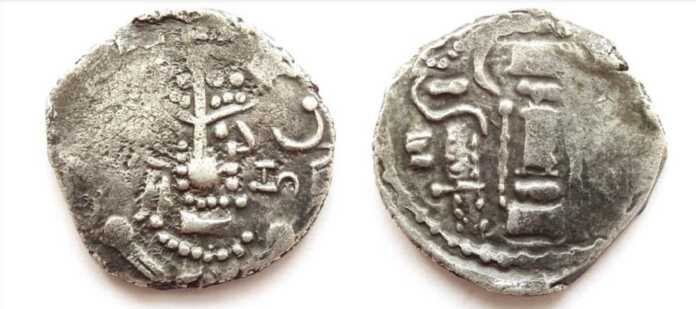Some important Malava Plaques From Nagar (Uniara) were found From the surface of the ruins Carlleyle at Nagar in the Uniara Thikana.
The ancient ruins at Nagar in the Uniara Thikana of the former Jaipur State, now in the district of Tonk, have been known for a little less than a century from the account left by Carlleyle of his explorations conducted at site in 1872.[1]
From the surface of the ruins Carlleyle had collected besides other finds about 6000 Malava coins, which, According ‘where in many places lying as thick as shells on the seashore’.
This reported plethora of the Malava coins of which until recently this site was the sole provenance, coupled with its vast extent exceeding that of any known ancient ruins in Rajasthan rendered Nagar an enchanted field for the archaeologist, who was struck with a romantic admiration for the site and eagerly looked forward to the unraveling of its mysterious treasures by regular excavations. [2]
The celebration of Bimillenuiun of the Vikrama era in 1943 offered a suitable opportunity and Sri K. Deva, the then Superintendent of Archaeology, Jaipur State undertook excavations at Nagar, the city of the Malavas, who were known to be vitally connected with the Vikrama era during the early periods of its currency.
Though the operations were confined to trial diggings at a few selected spots over the extensive ruins, the results were able to show th at the town of Nagar, known in antiquity as Malava Nagar was founded by the Malavas about the beginning of the Christian era and continued in occupation till the mediaeval period.
In all nearly five hundred portable objects besides one thousand pottery specimens were recovered as a result of excavations. Among these the slate plaques form a very interesting group of finds. Most of these came from the two upper strata and are datable to C. 900 to 600A.D. The slate plaques from Nagar present a striking stylistic affinity between themselves and those from the upper levels of Ahichchhatra assignable to the same period.
Most of these plaques bear religious figures and a few fragments are seen to be decorated with floral and geometric patterns and representations of animals like fish and crocodile. The more important plaques are noted below:-
(a) Plaque bearing an image of potbellied Ganesha (बड़े पेट वाले गणेश), almost in round. He is represented as seated, holding in his right hand an object, which may be a tusk, and in his left hand a modaka which he is taking with his tusk. Though lord Ganesha is wearing a dhoti in the loar part of the body but on upper part there is a sacred thread only. This is a fairly well-finished piece, the modeling of the forehead being particularly attractive.[3]
(b) Slate plaque carved with the figure of a Naga with three hoods at least. This may be compared to a similar plaque from the Ahichchhatra Garh site at Ujjain. [4]
(c) Plaque carved in the middle with the half length figure of a male deity set in a circular frame. The lower portion is divided in three panels, the middle one being decorated with what looks like an altar while those on the proper right and left flanks showing elephant and horse respectively. The male deity has a dignified expression on his face and wears a prominent headdress. He holds in his both hands an identifiable object which is represented like a banner. If this object is taken to be a lotus flower, the deity may have to be identified as Sun god.[5]
(d) Malava Plaques on Slate representing Mahishasurmardini, standing and piercing the neck of the buffalo demon with a spear held in her right hand and trampling the demon’s head under her right foot. The front half of the buffalo demon is seen prostrate while his hind body is upraised. It is likely th at the Goddess held the tail of the demon with her left hand, which is mutilated along with a portion The figure which is executed in relief, shows a crude workmanship of her head. [6]
(e) A Slate plaque carved with a crudely executed squatting Goddess holding in both her hands an identical object, which is represented like a banner. If this object be identified as lotus, the figure would become a representation of Lakshmi. Similar type of crude figures are found on many Indian sites like Ahichchhatra Garh site at Ujjain etc.[7]
(f) The Fragment of a plaque represents a head of Shiv carved in relief.[8]
(g) Ekamukha Sivalinga of slate carved in round. The Jatabhara of the matted locks marked with the crescent and the third eye of Shiv are prominently depicted on the head, which is slightly defaced.[9]
(h)A plaque carved with a crude stumpy figure of a deity represented as standing and holding a lotus flower in the right hand. It may be a representation of Lakshmi, though it must be admitted th at there are no indications of the female sex.[10]
Stone images being very few from this site, the slate plaques discussed as above throw an interesting light on the plastic art prevailing in this region in the early mediaeval period.
Thus we see that Malava Plaques From Nagar (Uniara) have a great historical value of two thousand year old cultural history of India.
[1] Cunningham’s Archaeological Survey of India Report Vol. VI. pp. 162-195.
[2] Dr. Satya Prakash, Some Interesting Plaques From Nagar, Rajasthan History Proceedings, 1968.
[3] NG. 45, Tr. A II Stratum.
[4] Annual Administration Report of the Archaeological Department Gwalior State (1940-41, pl. IIb; NG. 61, Tr. A. II Stratum.
[5] NG. 145, Tr . A. II Stratum.
[6] NG. 86, Tr. A. 1st Stratum.
[7] NG. 206, Tr. A. II Stratum.
[8] NG. 42, Tr. A. I Stratum.
[9] NG. 292, Tr. 1st Stratum.
[10] NG. 293, Tr. C from the well in deep pit. 2.




